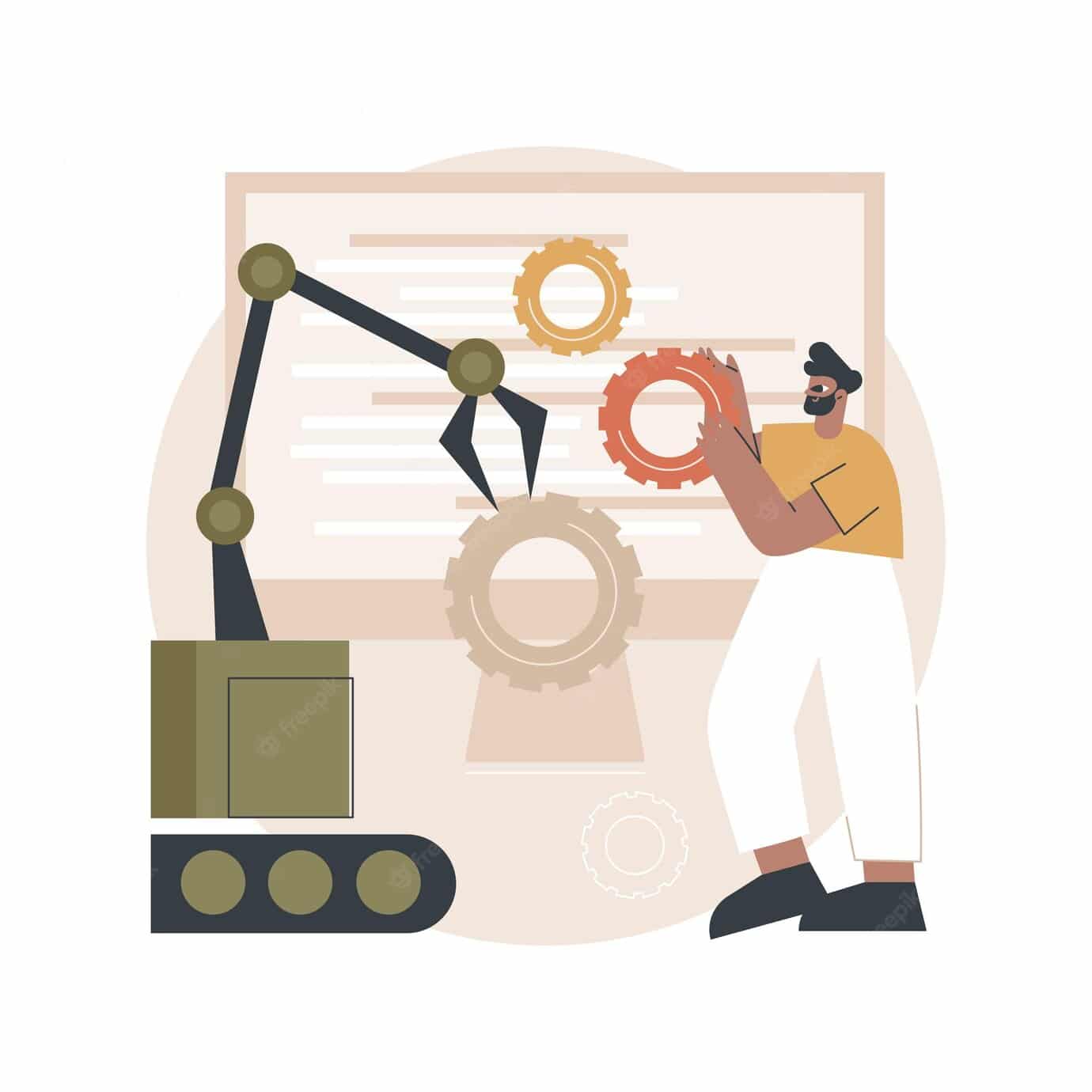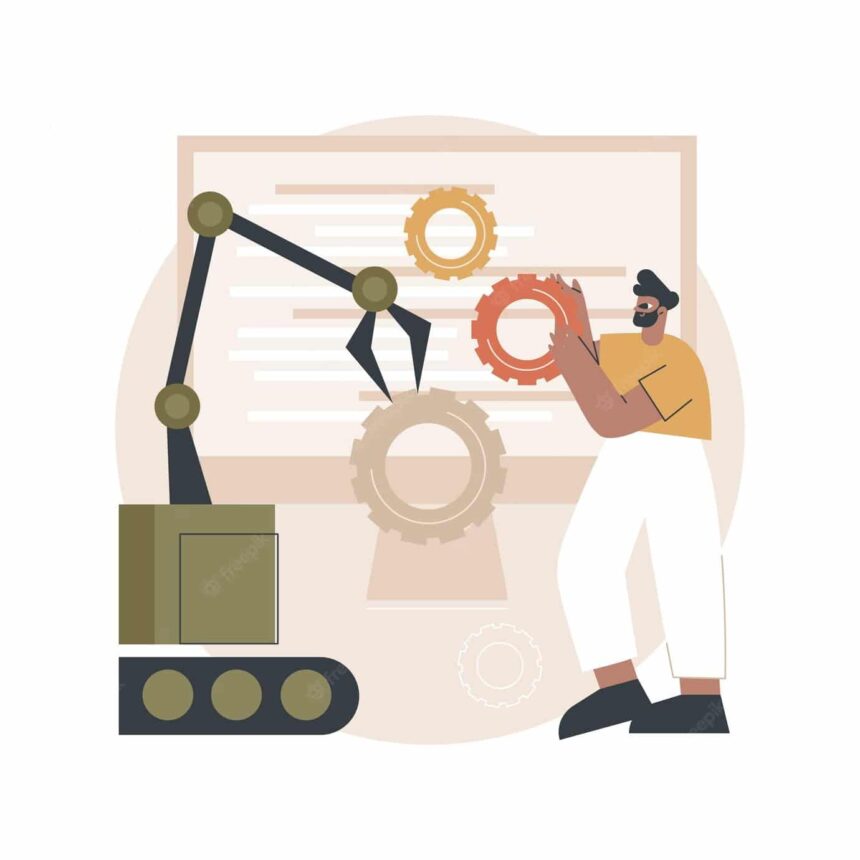
Human-robot collaboration: Welcome, fellow robot!
Robots and humans already work together in the manufacturing process today. Human operators are aided and relieved by robots. They are also able to automate tasks in a variety of ways and increase their productivity. Collaboration between humans and robots (HRC) is an element that combines the efficiency and precision of machines with the human ability to do certain tasks.
Table of contents
What Is a Collaborative Robot?
A collaborative robot was developed around the time of the turn of the century and it was released to the public. The robot is intended to perform automated tasks around human operators. This is different from other industrial robots that are stationary. The purpose of those robots is to be isolated from humans. This is achieved using physical barriers and other safety devices. Collaborative robots are designed with unique functionality that allows them to work around people in an environment conducive to collaboration. These features can include things like:
Speed limitations
Payload capacity limitations
Force detection
A collaborative robot could technically be any robot that is capable of collaborative work. It should be noted, however, that most commercial collaborative robots are designed with six axes, which makes six-axis designs the most commonly available. The design of this collaborative robot enables it to be used in many different scenarios.
There are some significant differences between collaborative robots and industrial six-axis robots. Unlike industrial six-axis robots, collaborative robots are designed to work with people. In addition, collaborative robots are easier for non-experts to interact with as they are easier to program. This includes reprogramming the robot and making adjustments to its parameters as well. For the most part, the development environment is fairly graphical and intuitive. This is in contrast to the comparatively complex development environment of industrial robots.
The cobots themselves are also lighter in comparison with their industrial counterparts. As a result, the robots can perform in dynamic environments when paired with mobile robots. A cobot could perform a machine tending task on a routine basis for a certain period of time. Then, when it is required elsewhere, the mobile robot will transport the cobot to a new location. At this point, it will be able to perform its next task. With this added flexibility, the cobot can have a much greater impact on your manufacturing environment.
There are strict design limitations imposed by the International Organization for Standardization (ISO) on cobots. So you can be sure from brand to brand there is a baseline level of “collaboration” and safety specifications that are respected.
ISO defines 4 types of collaborative robot operation modes:
1. Power and Force Limiting
This method institutes force limitations via a force feedback system. The robot will stop its motion in case it contacts a person or object, which means it will behave in a controlled manner. It is necessary to limit the force and speed of the robot given its inertia in order to prevent the robot from moving forward. “Collaborative speed” is defined as no more than a speed of 250 mm per second. In spite of that, it must be noted that using a collaborative robot does not mean there is a zero level of risk. This is because each and every use case is different. A risk assessment should be carried out and applied properly in order to ensure a safe working environment.
Whenever a robot is deployed or reconfigured to a new station or task, you have to perform a risk assessment for the whole application and reassess again when redeploying the robot. In short, it is a process of evaluating and then addressing the risks that arise.
One of the most common methods of cobot operation is power and force limiting. Power and force limiting allows for the most suitable work envelope between human and robotic operators. With this mode, interruptions do not adversely affect productivity or efficiency. In addition, this method does not require external equipment to function. This is because the force feedback system of this robot is built into the robot itself. A combination of hardware and software makes up this system.
2. Speed and Separation Monitoring
This method uses sensing equipment to monitor the surrounding area. This is done in order to control the robot’s movements based on the sensor data. Sometimes this area is called the extended work envelope for a reason. Equipment such as this is generally used to watch an area for humans or equipment. The robot will react in a timely manner to the approach of the operator or forklift by the work cell. The robot will either slow down or restrict its range of motion, or it will do both, until the human or object enters the stop zone. At that point, all motion in the robot will cease. The robot will begin moving again as soon as the obstruction has been removed from that defined area. Human-robot collaboration can also be implemented with industrial robots as part of the human-robot collaboration process.
3. Hand Guiding
An operator can operate a robot remotely by hand by using a control module, which allows an operator to operate the robot remotely. Such applications are often seen in the lifting of heavy and dangerous materials. Traditionally, this involved the operator taking over the motion control for these materials.
Now, these technologies are being used to enable the use of “hand teaching”. The use of this technology can be seen in many modern collaborative robots. With the help of controls on the robot, an operator can teach the robot steps in a process by hand. For an industrial robot to have the ability to teach itself, it would need to be fitted with a force-sensing device.
4. Safety Monitored Stop
We see safety monitored stops being used often, even for industrial robots that are used for a wide range of purposes. Whenever a person enters the working area of the robot, the robot will stop completely. A number of systems, including laser curtains, emergency stops, and special locks on the cell doors, are used in order to detect if a human is entering the cell area. This collaboration mode is also used for maintenance teams to work on the robots.
There are collaborative robots that use a combination of these methods. Using these methods, collaborative robots are flexible and can operate in highly dynamic environments. It is important to remember that each application is different. To ensure a safe working environment, regardless of the type of robot, a risk assessment should be conducted and properly implemented.
Also Read: Working with AI: Real Stories of Human-Machine Collaboration
Which Industries Use Collaborative Robots?
Collaborative robots are used across a wide range of industries and have a wide range of applications. Their general-purpose design allows them to be applied across a wide range of industries. A few examples of industries that make use of cobot technologies include:
- Packaging
- Pharmaceutical
- Food and beverage
- Electronics
- Logistics
- Metals
- Plastics
- Automotive
- Aerospace
Cobots are present in almost every major industry. They are designed in such a way that their features make them suitable for a variety of tasks.
Cobots: the status quo of flexible production
Flexible manufacturing with variable batch sizes with maximum efficiency – that is the challenge for manufacturing in the future. To meet that goal, human-machine interaction will be required throughout all phases of robotic automation implementation, which will make it easier and faster to set up, install, commission, program, operate, maintain, and reuse robots in all applications.
It is common to find many of the production steps in modern factories to be automated and carried out by machines. In order to ensure the smooth running of manufacturing processes and the quality of the product, human knowledge, intelligence, flexibility, creativity, and sensitive touch are essential.
Unlike conventional industrial robots, collaborative, sensitive robots, which are also known as cobots, allow not only easier commissioning and programming of robots, but are also likely to work directly together with production workers, easing their workload. It is possible for them to perform strenuous, unfavorable ergonomically unfavorable and monotonous work, such as overhead work or repetitive tasks. It takes relatively little floor space for them to function, as any safety equipment required can be designed in a space-saving manner.
Cobots are equipped with integrated sensors, which enables them to automate delicate assembly tasks, from assembling automotive transmissions to inserting rubber plugs to handling flexible parts using their hands.
When unexpected contact occurs, a different solution is defined for every specific application: either a stop is triggered or the robot reduces its speed sufficiently so that any risk of injury is reduced.
If robots and humans can work together safely without fencing separating them, then many of the conventional safety precautions will no longer be necessary. People and robots can work together without posing any safety risk.
Also Read: Robotics and manufacturing.
Forms of HRC: coexistence, cooperation, collaboration between humans and robots
As a matter of fact, humans and cobots can work together with varying degrees of proximity depending on the application. Though the term “human-robot collaboration” is the one that is most commonly used, the “C” in HRC can stand for a variety of different forms of collaboration.
Coexistence:
Robots and humans work together in the same space without a safety fence between them. Despite the fact that they work independently of one another and do not share a common workspace, they do not work together on the same tasks. In this case, the sensitivity and safety of a cobot can considerably ease and speed the commissioning, programming, and re-use of the robot due to the fact that most cobots are lightweight, easy to operate, and can be taught to operate with minimal training.
Cooperation:
A human-robot cooperation is when humans and robots work together in the same space. During the course of a process, they work alternately on the tasks assigned. There is no direct interaction. In a collaborative environment, the use of fences is not necessary, either because the cobot is inherently safe or the workspace is protected with sensors.
Collaboration:
Humans and robots work together in a shared workspace. The robot might pass something to the human operator, or the two may simultaneously work on the same piece of equipment.
The new generation of robotics
It is possible for humans and robots to work directly together on highly sensitive tasks thanks to the availability of these collaborative, sensitive, and lightweight cobots, which can make implementing robotics easier and faster. The applications of adhesive bonding in industrial production range from assembly, testing, and material handling processes, to adhesive bonding processes in material handling applications.
Among other things, it is because cobot are not only extremely precise, flexible, and reliable, but they can also be used in a wide range of different working environments.
Collaboration between humans and robots facilitates precision work that is both safe and efficient.
Also Read: Artificial Intelligence the self-designing machine.
Human and robot – BMW
As opposed to the past when employees at the BMW plant in Dingolfing had to lift and join heavy bevel gears for front-axle transmissions by themselves, today they work alongside their collaborative colleague, the LBR HRC solution developed specifically for this customer, KUKA has enabled the car manufacturer to automate arduous production steps that were previously carried out manually and permanently ease the workload of its employees. Contacts detected by its sensors are picked up immediately and LBR iiwa responds without delay. As a result, close cooperation between human and robot is possible entirely without safety fencing.
Upgrading Construction Jobs with the Autonomous Track loader
Build Robotics’ autonomous track loader (ATL) is a compact track loader which is equipped with a LiDAR, or light detection and ranging sensors and augmented GPS, which allows it to work without the need of an operator. An autonomous vehicle like this one is designed for certain light construction tasks, such as excavating for a house.
Dozers
There are several types of dozers, and they can be used to do anything from pushing heavy loads to leveling a variety of soil types. An autonomous dozer from Built Robotics is capable of all that, without a human being being behind the wheel.
SPOT – Boston Dynamics dog.
Higher level of automation
Cobots complement the capabilities of human workers and enable the fast automation of production steps that were previously performed manually.
Eased workload for employees
Physically demanding, hazardous and monotonous work steps can be taken over by collaborative, sensitive robots. This relieves the burden on employees.
Consistently high quality
Repetitive and high-concentration processes are performed by collaborative, sensitive lightweight robots with the utmost precision, thereby improving production quality.
Maximum flexibility
The tasks of collaborative robots can be flexibly adapted. Furthermore, collaborative robots can be deployed in varying locations and with low space requirements.
Medical robotics.
Robotic surgery is a surgical procedure that uses a robotic arm to manipulate surgical instruments. The procedure is performed through small incisions, resulting in less pain and scarring than traditional surgery.
Mobile robots
Flexible and efficient intra-logistics within production facilities are enabled by mobile robots and autonomous transport systems.
Industry 4.0
Artificial intelligence has completely changed the way robots work. Now modern robots can learn new tasks and instruction with time due to machine learning algorithms. That’s why we can see robots working side by side with human workers in some factories such as the Tesla Gigafactory.
The new concepts and ideas are emerging from using robots in manufacturing because of the benefits they bring. Robots automation upgrades manufacturing with a sophisticated and accurate working environment.
They also offer the confidence that we need and allow us to spend our time on more important decision-making matters. The following are the most significant reasons why we should consider using robots in manufacturing:
- Robots work efficiently and save time all the way from managing raw material to packing the final product.
- It’s possible to customize a single robot to perform multiple tasks simultaneously.
- The robots do not need breaks and they can work 24/7 for continuous production.
- It allows organizations to stand out from the competition, and that’s why the trend to use robotics in manufacturing is dramatically increasing.
- Automation, like in other fields, is always cost and time effective, and robotics can support companies of any size, even in small shops.
- Robots allow you to save your money by freeing up human resources that you have to spend in multiple streams.
- Robotics in manufacturing also helps workers by keeping them from dangerous, mundane, and repetitive tasks.
The Future of Cobots: Predicting the Next Wave of Robotic Teamwork
The emergence of cobots, or collaborative robots, represents a significant leap forward from traditional robots, marking a new chapter in the ongoing industrial revolution. These robotic systems are designed to work alongside humans in various industrial settings, establishing a new paradigm in human-robot interaction. Cobots, such as those designed by Universal Robots, bring the flexibility and ingenuity of human labor together with the precision and reliability of robotic technology. Their design accommodates a unique combination of both human and robot strengths, fostering a human-robot team that can execute industrial tasks with unprecedented efficiency and safety.
Collaborative robotics are poised to dramatically alter the production processes of the manufacturing industry. Instead of being cordoned off behind safety barriers, cobots can perform a variety of industrial tasks alongside humans, ranging from precision assembly to heavy lifting. Unlike traditional robots, which often perform repetitive tasks in isolation, cobots are designed to engage in more complex, collaborative applications. They can be trained to perform dangerous tasks that are unsafe for humans, enhancing workplace safety while also increasing productivity. Cobots come with adjustable safety settings and often feature force-limited design, which ensures safe human interaction, even in close quarters.
The future of cobots points towards a more harmonious integration of robots and humans in the workplace. Advances in artificial intelligence and machine learning will enable cobots to learn and adapt to their human colleagues’ working styles, fostering a deeper level of collaboration. Cobots will become more adept at understanding and responding to human instructions, gestures, and even emotions. As technology evolves, the robot arm’s precision and speed will complement human dexterity and problem-solving capabilities, optimizing the production process. In this vision of the future, cobots and humans coexist and collaborate, each bringing their unique strengths to bear on the tasks at hand, resulting in increased productivity, improved safety, and a revolutionized manufacturing industry.
Safety First: How Cobots are Designed for Safe Human Interaction
The hallmark of collaborative robotics, or cobots, is their inherent safety design for effective human-robot collaboration. Unlike traditional industrial robots, which are often isolated from humans for safety reasons, cobots are explicitly designed for interactive operation in close proximity to humans. This significant characteristic enables safe human-robot collaboration in diverse assembly tasks and a range of industries, marking a new phase of cobots in manufacturing. Fluent human-robot interactions are achieved by incorporating advanced sensing technology, machine learning techniques, and safety features into cobots’ design, allowing them to perceive their environment and adapt their behavior accordingly.
In the area of human-robot collaborative assembly, cobots are changing the landscape of flexible manufacturing and modular production systems. Cobots are integrated with sensors that allow them to detect human presence and adjust their movement speed or stop altogether when a human operator enters their working zone. This capability is essential for ensuring safety during the implementation of cobots in human-occupied environments. Cobots often have force-limited mechanisms that control their exertion of force and speed, further ensuring human safety during collaboration in assembly tasks.
The evolution of cobots is expected to leverage machine learning techniques for more advanced and creative performance. Through artificial intelligence, cobots will learn from their human counterparts and adapt to their preferences and skills over time. This learning ability will foster more natural and intuitive interactions, enabling smart manufacturing systems where humans and robots can work hand-in-hand safely. The development of these techniques will allow cobots to participate more effectively in complex, delicate, or unpredictable tasks, making them an indispensable part of the future workforce. The paradigm shift to safe, efficient, and versatile cobots not only enhances productivity but also transforms the factory floor into a safer, more human-friendly environment.
Incorporating Cobots into Your Business: Steps to Success
Incorporating collaborative robots, or cobots, into your business operations is a strategic move towards increasing production efficiency and transforming workspaces into safer environments. These cooperative robotics systems seamlessly blend into existing workflows, performing tasks that are typically difficult, dangerous, or monotonous for human workers. As such, they play a significant role in reducing the quantitative workload on human operators, allowing them to focus on tasks that require complex decision-making, creativity, and qualitative workload, such as quality control or strategic planning.
The first step towards successful implementation of cobots involves evaluating your current production systems and identifying areas where automation can enhance efficiency. Cobots excel in modular production systems and collaborative assembly tasks. They can be programmed to perform a range of tasks such as packaging, quality inspection, material handling, and more. Their utility in various tasks makes them a versatile tool, capable of adapting to different production needs and providing flexibility in manufacturing processes.
Deep learning and machine learning techniques form the core of cobots’ capabilities. These AI-driven techniques enable cobots to learn from their human counterparts, improving their performance over time. They can recognize patterns, adapt to changes in the working environment, and refine their actions based on feedback. This aspect of ‘learning while working’ enhances their ability for safe human-robot collaboration. It is essential to train your workforce in managing cobots and utilizing these techniques to achieve the full potential of this collaboration, marking a new phase of cobots in manufacturing.
The final step is to integrate cobots into your smart manufacturing systems. The deployment should be strategic and gradual, allowing the workforce to adjust to their new robot colleagues. It’s important to remember that the goal is not to replace human workers, but to augment their capabilities and productivity. By enhancing your production efficiency, reducing the workload, and fostering creativity, cobots can pave the way for the successful digital transformation of your business. Always ensure safety guidelines are adhered to and that regular maintenance is carried out to ensure the longevity of your cobot investment.
The Economic Impact of Cobots: Boosting Efficiency and Reducing Costs
The rise of collaborative robots, or cobots, in the industrial sector has prompted a significant shift in production efficiency and cost management. As elements of cooperative robotics, cobots are designed to work alongside humans in a shared workspace, enabling fluent human-robot interactions. This synergy not only leads to a more efficient production process but also aids in reducing operational and production costs, delivering a strong economic impact.
In terms of production efficiency, cobots can handle a range of applications that were previously labor-intensive, error-prone, or hazardous. They are employed in assembly tasks, packaging, machine tending, and inspection roles, among others. By taking over such tasks, cobots reduce the quantitative workload of human workers. This allows employees to focus on qualitative workload, including tasks that require human ingenuity, creativity, problem-solving abilities, and decision-making skills. As a result, productivity levels can soar while maintaining a high standard of quality.
Deep learning and other advanced technologies imbued within cobots enable them to learn and improve over time. They adapt to changes, identify patterns, and refine their actions based on the feedback received, making them an invaluable asset in various industrial settings. In this way, cobots contribute to the creation of smart manufacturing systems, where tasks are performed more accurately, rapidly, and consistently than with human labor alone.
By mitigating the risk of workplace accidents and reducing the need for repetitive, physically demanding tasks, cobots can lead to significant savings in terms of workers’ compensation, insurance, and healthcare costs. They also reduce downtime by working continuously without the need for breaks, thereby speeding up production times and reducing overhead costs. The reduction in production costs, combined with the increase in production efficiency, contributes to a higher return on investment (ROI), making cobots a financially viable and beneficial addition to the modern industrial workspace.
Exploring the Ethical Implications of Cobots in the Workplace
As we increasingly integrate cooperative robotics, specifically cobots, into our workplaces, it becomes crucial to explore and consider their ethical implications. Cobots, with their deep learning capabilities, are reshaping many facets of job performance. They are aiding in boosting production efficiency and easing the quantitative workload of employees. These changes also present potential challenges related to job displacement, privacy, and safety, which demand careful examination.
Job displacement is one of the significant concerns as cobots become commonplace in many industries. As cobots take over repetitive, monotonous tasks or jobs that pose a risk to human health, the quantitative workload of human employees changes significantly. While this shift allows employees to focus more on the qualitative workload that demands creativity, critical thinking, and decision-making, there is also a risk of job losses in certain sectors. Therefore, it’s essential to strategically plan the implementation of cobots in a way that complements human labor rather than wholly replaces it.
As cobots are equipped with deep learning capabilities, they can gather vast amounts of data to improve their performance, leading to more fluent human-robot interactions. This data collection can raise privacy concerns. Ethical considerations must guide the kind of information cobots can access, how it’s used, and the security measures protecting this data. Employees should be well-informed about these factors to maintain transparency and trust in the workplace.
While cobots are designed to work safely alongside humans, ensuring this safety in all aspects of human-robot collaborative assembly is a continuous task. Accidents can occur due to malfunctions or unpredicted situations, potentially leading to physical harm or damage. Therefore, rigorous safety protocols and standards must be in place, and regular inspections and updates of the cobot systems should be part of the operational routine. Addressing these ethical implications head-on is a critical phase in the successful integration of cobots into the smart manufacturing systems of the future.
Conclusion
As we progress deeper into the age of automation, the implementation of cobots, or collaborative robots, is transforming the way businesses operate. These robotic systems, underpinned by deep learning and machine learning techniques, are becoming integral parts of smart manufacturing systems across various industries. Cobots differ from traditional industrial robots in that they are designed to interact and collaborate safely with humans, allowing for more fluent human-robot interactions, thereby revolutionizing facets of job performance.
The primary attraction of cobots lies in their ability to work alongside humans in shared spaces, enabling human-robot collaborative assembly. This capability is achieved through advanced sensors, machine learning techniques, and control systems, ensuring safe interaction between humans and cobots. Consequently, cobots are designed to handle a variety of tasks, from the mundane and repetitive to the complex, requiring precision and consistency. This dynamic significantly reduces the quantitative workload on human employees, allowing them to focus more on tasks involving the qualitative workload such as planning, critical thinking, and creative performance.
We are still in the early phase of cobots’ integration into industries, yet their impact on production costs and efficiency is already evident. Cobots, being versatile and flexible, can be rapidly deployed and reprogrammed to perform a wide range of tasks, reducing the need for specialized machinery. Their precision and consistency reduce error rates, leading to higher product quality and reduced waste, which ultimately results in lowered production costs. Their ability to perform tasks round-the-clock without breaks contributes significantly to improving productivity and efficiency.
With the advancement in Human-robot interaction, the future of teamwork is bound to evolve. Cobots will continue to grow more intelligent and more autonomous with the advancement in machine learning techniques and deep learning. They will be able to learn from their human counterparts and adapt to their preferences, further enhancing the fluidity of their interactions. This ongoing progress will lead to more complex tasks being assigned to cobots, reshaping the conventional teamwork model. The future will witness cobots and humans working in tandem, each contributing their unique strengths, to achieve shared objectives.
References
Liu, Lin. Human-Human vs. Human-Robot Collaboration: Applying Factors Influencing Collaboration between Humans to Human-Robot Collaboration. GRIN Verlag, 2019.
Matt, Dominik T., et al. Industry 4.0 for SMEs: Challenges, Opportunities and Requirements. Springer Nature, 2020.
Matthews, Peter, and Steven Greenspan. Automation and Collaborative Robotics: A Guide to the Future of Work. Apress, 2020.
Vukobratovic, Miomir. Dynamics and Robust Control of Robot-Environment Interaction. World Scientific, 2009.











